Salvador da Bahia is Africa’s beating heart in Brazil. It’s home to the largest population of Afro-Brazilians, and Salvador’s residents, known as soteropolitanos, are proud to call their city “the black Rome.”
Everything from Carnival to government ceremonies in Bahia honors Salvador’s African spirit. The city’s motto, terra da alegría (land of happiness), stems from its proud African history, music, and culture of resilience. Yet despite the capital’s black majority, the political and media powers of Bahia remain in the hands of the white elite. The imbalance and exclusion have led to festering social issues in the city.
Living for years in the charming yet complicated historic district helped me see the duas caras (two faces) this mystical city wears. The cidade alta (upper city) is built on a cliff, and overlooks the cidade baixa (lower city). Under the Portuguese empire, the upper city was where the political elite lived, while the lower city was the economic district, where they handled their business, including the ports where African slaves arrived. Salvador’s duas caras are also reflected in the fact that while the Brazilian government is happy to applaud its African city’s black culture, it ignores the deadly levels of police violence toward Afro-Brazilians. A majority of Salvador’s black residents suffer from racism on a daily basis. It’s common for tourists walking around the historic district to witness an innocent group of young black men suffer violent police pat-downs that are humiliating and terrifying for the victims. The duas caras are also seen in the clear division between the wealth of the historic district and the intense poverty in Salvador’s favelas.
Despite this harsh reality, music, dance, and outdoor festivals are a mechanism of survival passed down through generations to keep the morale and spirits of Baiana people alive.
If you stay in the barrio of Santo Antônio in the cidade alta—which I recommend, given its charm, romantic sunsets, and endless party vibe—you can experience local life from both the alta and baixa perspectives.
It’s key to keep safety in mind. Don’t be flashy. And don’t be surprised if your plans change. You’re on Bahia time.
7:00am
Pousada do Boqueirão
R. Direita de Santo Antônio, 48 – Santo Antônio Além do Carmo, Salvador (Bahia) – BA, 40301-280, Brazil
Breakfast, or café da manhã as it’s called in Brazil, happens early, and the coffee never disappoints.
For a more cidade alta experience, go to Pousada do Boqueirão, a vintage baiano hotel that feels like an art museum. The back opens onto a beautiful terrace with a great view of the Bay of All Saints, with ports and lush jungles leading down to the lower city. There you can enjoy some of Salvador’s morning favorites, including gluten-free options like bolinho de estudante, a rolled dough of tapioca flakes, grated coconut, coconut milk, and sugar, deep-fried then rolled in cinnamon and sugar; or different cuscuz baianos, made of both corn and tapioca, mixed with sugar, coconut milk and shreds; the famous tapioca-based, taco-shaped beijus come with various fillings, served with strong coffee or espresso drinks; and fresh juice options like guava and tamarind. Be sure to browse around this lovely hotel, where the jungle seems to have grown into the walls.
A more local and economical option is Padaria Santo Antonio, a modest bakery-turned-cafe a few doors down with noticeable blue-and-white-checkered tiles. Enjoy the freshly squeezed juice options, pastries, and colorful cakes.
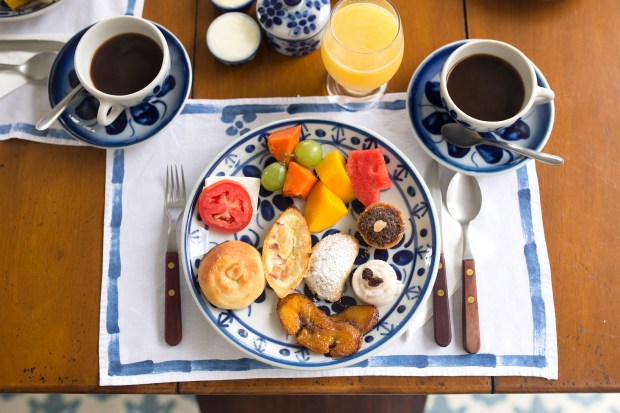
If you’re feeling adventurous, try the Nutrilar supermarket. To get there, take Travessa José Bahia, an alley known for its socially provocative graffiti. Make a left at the end of the alley on Rua dos Adôbes; keep right and follow the street around the corner, where you will see the Nutrilar. I don’t recommend walking down this street at night or when it isn’t busy. Inside the Nutrilar is a counter where you can order freshly made sandwiches, burgers, smoothies, juices, pastries, and baiano cakes. My favorite, the bolo de aipim, is a gluten-free breakfast cake made of coconut and manioc (cassava). Or try the addictive açaí na tigela (frozen, mashed acai), served with granola and bananas. Most baianos eat their breakfast at the counter and then leave.
Don’t forget to try the cafezinho, finger-size cups of strong coffee, served preto (black) or com leite (with milk), sold by local vendors for 50 centavos (15¢) from boxed carts blasting street music.
Take photos of the colorful colonial buildings that date back to the 16th century along Rua Direita do Santo Antônio. You will pass quaint restaurants, hole-in-the-wall stores that transform at night into makeshift bars, cafes, boutiques, and dance studios. Head to the Praça do Santo Antônio, a plaza where you’ll see the daily activities of those who live in the area or commute from outside the city for work.
If you are a believer, pay homage to Santo Antônio at the lemon-colored church in front of the plaza. Locals, when they feel lost, often seek guidance from Santo Antônio, commonly synchronized with the African orixá (god, or spirit) Ogum or Oxóssi in Candomblé, the Yoruban-based spirituality of Afro-Brazilians in the North.
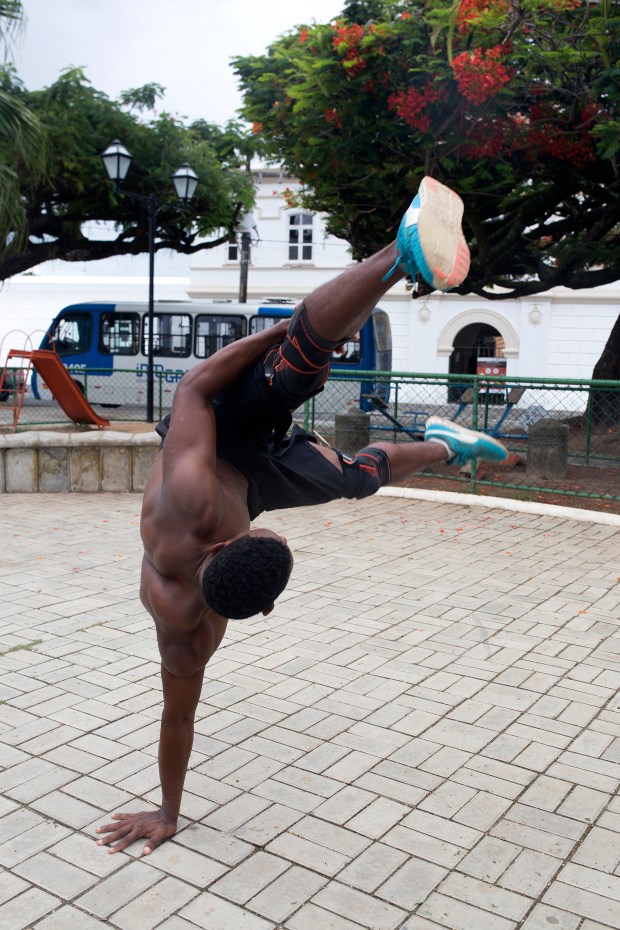
The massive white wall at the end of the plaza is the Forte da Capoeira (Capoeira Fort). Born in Salvador, capoeira is a mixture of martial arts and dance created by Angolan slaves as a means of physical and cultural resistance. The fort was originally built by the Portuguese to repel foreign invaders and served as a prison for Africans taken during the failed Malê uprising in 1835, when Muslim Africans launched a slave revolt against the Portuguese empire. The fort is now used to preserve the history and legacy of capoeira in Salvador. Capoeira icons such as Mestre Boca Rica and Mestre Bimba, who lived through Brazil’s capoeira ban in the 1920s, turned Salvador into one of the prime locations for international capoeiristas to master the art.
You will run into capoeira rodas (circles) throughout the day and hear the constant sound of capoeira’s primary instrument, the single-stringed berimbau, an ancient African instrument brought to Salvador by African slaves. In some Salvador barrios, schools and families require kids to train in capoeira. If you’re interested, take classes or ask for a private tour of the fort, which also serves as a community center where locals train, enjoy movie nights, and attend international capoeira events.
10:30am
Igreja Nossa Senhora do Rosário dos Pretos
Largo do Pelourinho, s/n – Pelourinho, Salvador – BA, 40026-280, Brazil
Candomblé will be another major theme throughout your day in Salvador. You will see it reflected in the culture, cuisine, lingo, music, and traditions—in the baiana women dressed in traditional garb, in the bands of young people on drum lines, and in the smell of the popular street snack, acarajé, frying in palm oil.
As you walk up the steep hill toward the main plaza, notice the ornate blue church on the left, with colorful ribbons adorning its gates. This is Nossa Senhora do Rosário dos Pretos. It’s one of the first places of African worship in Brazil, where slaves synchronized Catholic saints with their African orixás. Mass on Tuesday nights and Sunday mornings includes African songs and prayers.
When you reach the famed Pelourinho square, keep in mind that this is the location where Africans enslaved by the Portuguese were publicly tortured and murdered. The word pelourinho means “little whipping post.” Visit the Museu Afro-Brasileiro da UFBA, on the second floor of the coral building on the corner of the main square, Praça Terreiro de Jesus. You’ll find art illustrating the traditions, artifacts, and customs that crossed the Atlantic Ocean and still dominate Salvador’s culture.
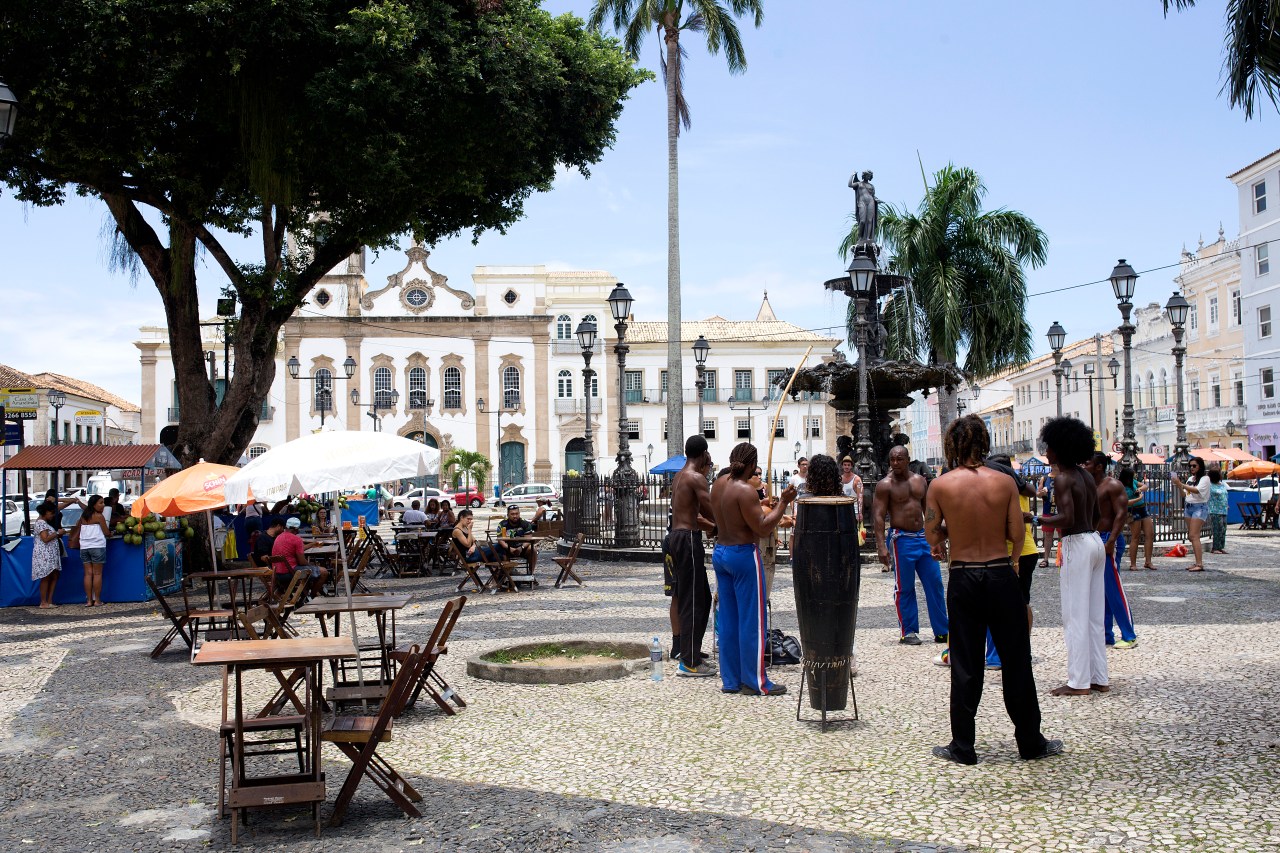
The nearby Fundação Cultural do Estado da Bahia (FUNCEB) is truly a marvel. The massive school, run by the government and independent donors, caters to the community’s passion for African and contemporary dance and music. It serves as a prestigious stepping stone for many Afro-Brazilian dancers who later perform on Broadway. Famous Afro-Brazilian dance instructors and an exhilarating live band attract huge crowds. As a former student, I can vouch for the electrifying experience of dancing to the rhythms and movements of the African orixás worshipped by so many Salvador residents. If you take a class, prepare to sweat and relinquish all personal space and inhibitions.
Across the courtyard is Casa do Olodum, home of the world-famous Afro-Brazilian drumming group. Like the dance school, Olodum is a source of community and African pride. Founded as an Afro-Brazilian alternative to the main Carnival circuit, Olodum is a percussion, art, and theater group that has nurtured local talent from the favelas for decades. Olodum’s sound of the slums, highlighting social issues, racism, and African pride, are one of the most identifiable sounds of Salvador da Bahia. If you are here during Salvador’s many festas (celebrations), watch them live. Crowds of baianas sway back and forth, singing all their songs as the drum lines shake you in your spot.
For an afternoon snack, try one of Salvador’s favorite street foods, acarajé. Acarajé is a burst of flavors and textures. Mashed black-eyed peas mixed with onions create a doughy paste rolled into a ball or deep-fried in azeite de dendê (palm oil). The acarajé is cut in half and served with delicious vatapá, a mixture of ground bread or bread crumbs, coconut milk, shrimp, peanuts, and dendê oil, topped with sun-dried shrimp. The acarajé also includes salad, a special spicy oil, and caruru, a mix of okra, shrimp, onions, and dendê oil. These foods all originated in Africa and are used as ritual offerings during Candomblé ceremonies. Dendê oil, which came to Salvador from Africa through the Atlantic slave trade, is such a major part of the cuisine here that proud baianas sport their African Pride with “dendê no meu sangue” T-shirts, meaning “dendê oil is in my blood.”
Walking toward the main bus stop Praça da Sé, you’ll find a mix of locals, street dogs, vendors, and entertainers around a statue dedicated to Zumbi dos Palmares, a warrior and hero to all Afro-Brazilians. Zumbi was a legendary African leader who broke free from slavery and led one of Brazil’s largest quilombos, or maroon communities, with tens of thousands of freed and escaped Africans. If you are here on November 20, nationally recognized as Black Consciousness Day, Zumbi will be covered in flowers, food offerings, and ceremonial gifts.
Past Praça da Sé on the far right is another plaza, with a giant cross, leading out to a fabulous view of the bay. Monumento da Cruz Caída is a reminder to all visitors that Salvador, which translates as “savior,” was the original capital of Brazil. In the same plaza you will find statues of African women in traditional garb at the Museu da Gastronomia Baiana, a small museum honoring baiana women, matriarchs renowned in Brazil for their cuisine and hospitality.
Along the way you will see local vendors selling cafezinhos, picolé (handmade fruit popsicles), and my favorite, cuscuz de tapioca com coco, a wet pastry made of tapioca flour, coconut, coconut water, and honey, served with condensed milk and coconut shreds. If you get a chance, buy popcorn from a street seller who will top it off with shreds of coconut and hot butter.

12:30pm
Elevador Lacerda
Praça Municipal, s/n – Centro Histórico, Salvador – BA, 40015-170, Brazil
Elevador Lacerda, an elevator that transports mainly locals from the upper city to the lower city and vice versa. It’s worth taking, and from here you can take a taxi to the famous Museu de Arte Moderna da Bahia, better known as the MAM. Once a sugar plantation on the water before it was transformed into an art center, the MAM hosts installation art, portraits, photography, music, and theater by local artists. It’s also popular for its laid-back jazz nights every Saturday, when locals and foreigners mingle, listening to music or enjoying the museum. Down by the water of the MAM, facing the cidade alta, you can see the artsy favela and beach of Gamboa, known for its Afrocentric murals and graffiti art. (If you seek out the Gamboa beach, always have a local accompany you there.)
Take a taxi back to where you started and you will notice the infamous Mercado Modelo directly across the road from the Elevador Lacerda in cidade baixa. It has great local vendors and food, but it’s a tourist trap and often feels eerie. Remember that it was once Salvador’s slave market; there Africans were forced on display, torn from their families, and sold to slave owners. Many were tortured and died in the market’s basement cells, and local urban legend has it that the ghosts of African slaves still haunt the area.


2:30pm
Caranguejo do Farol
Av. Oceânica, 235 – Rio Vermelho, Salvador – BA, 41950-000, Brazil
Head back to Praça da Sé on the upper level of the Elevador Lacerda and take the red bus to Morro do Cristo (Hill of Christ). Walk down the Venice Beach–like boardwalk of Porto da Barra, where you’ll find no shortage of people selling coconuts, caipirinhas, and beers—sometimes three for 5 reals ($1.50 – $2). Take a seat at one of the restaurants along the coast, either Caranguejo do Farol or, for a more local beachfront experience, Nago Moquecaria e Restaurante, in the heart of Porto da Barra. If you want something light, try the bolinhas do camarão or do bacalhau (deep-fried dough balls stuffed with shrimp or codfish and various spices), caldo de sururu (a thick, dark-gray shellfish soup, packed with baiana spices and served with lime and spicy sauce), or the escondidinho (barbecued meat and cheese stuffed in mashed yucca). But if you are looking to feast, try camarão com alho (garlic shrimp) or Bahia’s signature dish, moqueca. Originating in Salvador, moqueca is a thick, rich, deep-orange, slow-cooked stew with fresh coconut milk, traditional spices, fish, shrimp, ginger, garlic, peppers, and dendê oil. It’s served with rice, vatapá, caruru, and, of course, farofa (a cassava flour roasted in butter, hugely popular in Bahia and served with practically everything).
4:30pm
Porto da Barra Beach
Av. Sete de Setembro, s/n – Barra, Salvador – BA, 40130-000, Brazil
People-watch along the boardwalk in Porto da Barra. Baianas love sunbathing, showing off their latest swimwear, and drinking on the beach until sundown. Notice the men love sungas (tight swim briefs), and the women are usually in tiny bikinis, strutting back and forth along the water. But the beach is also family-friendly, and you’ll see people of all ages enjoying the warm ocean water and playing paddle ball and soccer. You definitely want to try the queijo. Local sellers with tin grills walk by and fry cheese right in front of you, topping it with oregano or molasses or spicy sauce or all three. If you’re lucky, you’ll see people joga-ing (the basic motion of capoeira) on the beach as the tide comes in. Grab a last drink and prepare for the sunset, when baianos clap, whistle, and give standing ovations as the sun disappears into the sea.
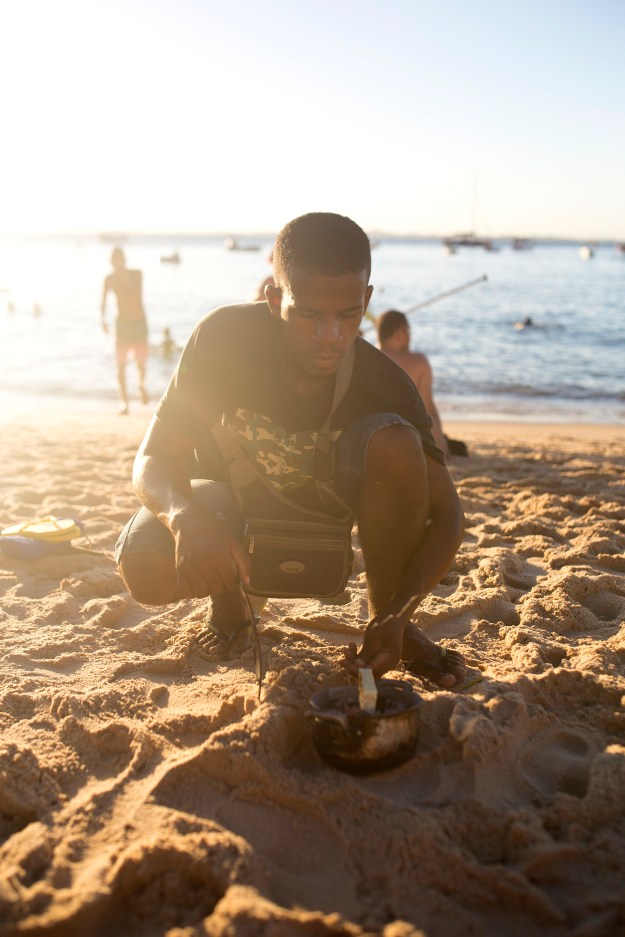


Take the public bus or a taxi back to Praça da Sé. If it’s Saturday, go directly to the MAM for jazz night from 6 to 9 p.m. If it’s any other day of the week, start your night off at O Cravinho, a cabin-like tavern that has as much character as its food has flavor. It’s packed with locals but the long lines to dine are worth the wait. They are known for their infusões, cachaca infused with flavors like pineapple, ginger, or beetroot. I almost always go with their signature drink, the Cravinho, which is cachaca infused with cloves and cinnamon. Definitely enjoy the mouth-watering garlic shrimp, which you should try eating with the shells like baianos do.
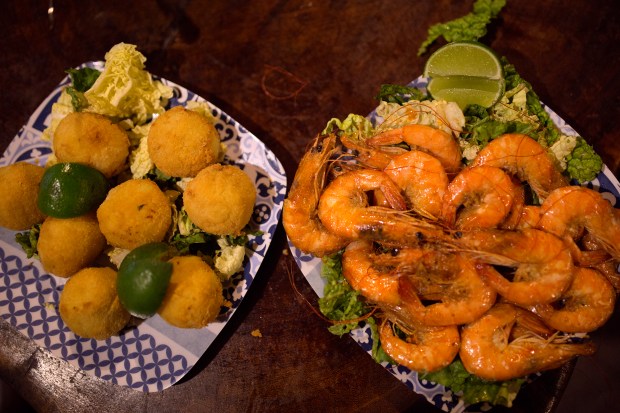
7:30pm
O Cravinho
Largo Terreiro de Jesus, 03 – Pelourinho, Salvador – BA, 40026-010, Brazil
On the way out of O Cravinho, grab a garrafa (half pint) of your favorite infused cachaça mix to enjoy as you head into the night. Baianos live for outdoor parties and live music, which you will encounter throughout the night. Be sure to check out the concerts at Largo Praça do Pedro Arcanjo, Largo Tereza Batista, and Praça do Quincas Berros D’Água for the region’s famous samba axé, samba reggae, and late-night partying.
10:00pm
ABOCA Centro de Artes
R. dos Marchantes, 12 – Santo Antônio Além do Carmo, Salvador – BA, 40301-430, Brazil
On the way back from excessive cachaça drinking and dancing, stop at the side of the Nossa Senhora do Rosário dos Pretos church, where you’ll find the Nevada Man working up his magic in a green tent. You won’t regret indulging in his creamy coconut cachaça delight, which has made him famous in the Pelourinho.
If it’s a Tuesday night, walk down the hill, and right next to the military police truck where “Babylon” is graffitied on the wall, you will see a samba party happening up the road, just outside a local unnamed dive. Throughout the week it becomes the location of Suvaco de Cobra nights, named after the beloved band that has brought down the house in this city for many years.
Now that you’ve danced and laughed the night away, walk back up Rua do Carmo and you will see the Cruz do Pascoal bar, packed with late-night revelers.
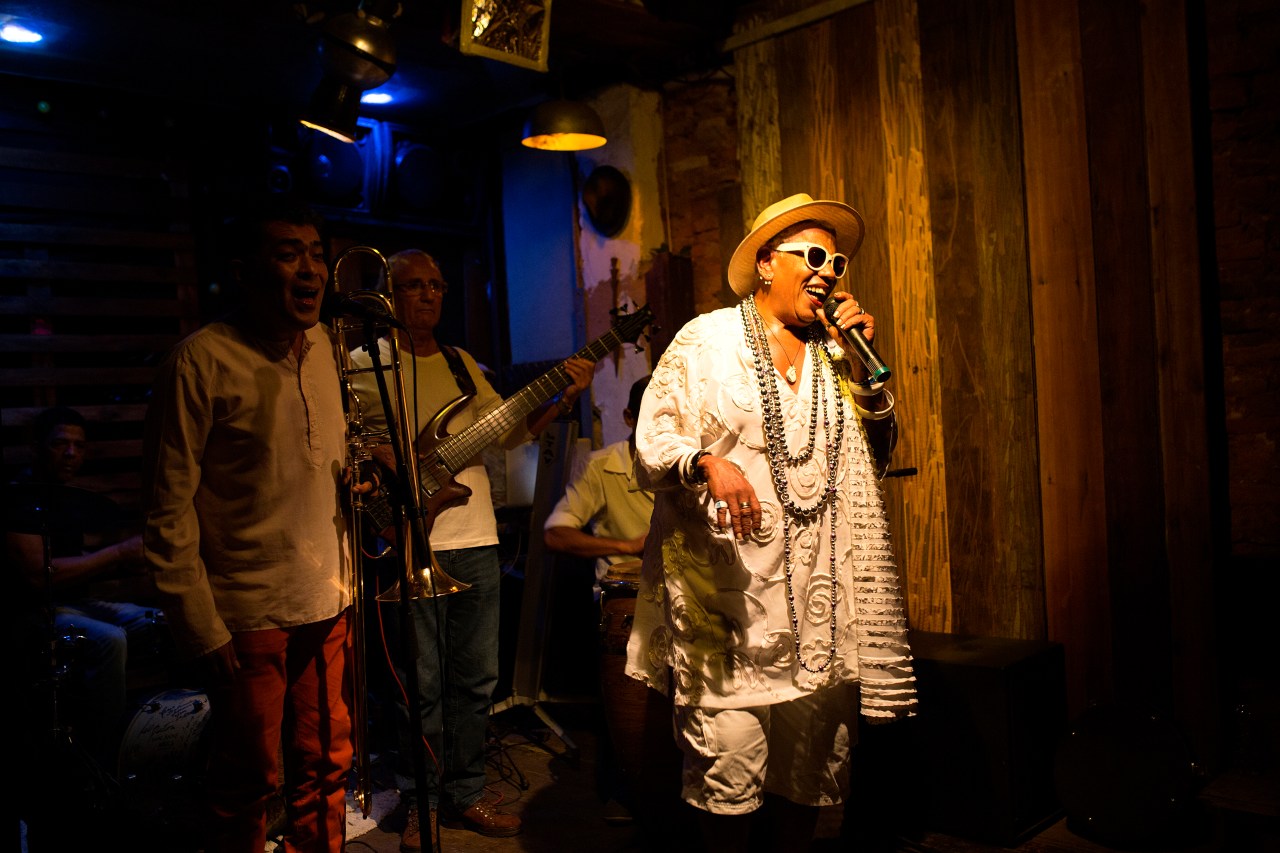
Finish your beer and head a few doors down to the ABOCA Centro de Artes, a culture center that turns into a party every Wednesday night from 9 p.m. to 1 a.m. The live music and diverse entertainment make it a fun place to meet locals and continue and dancing. If you get hungry, they serve pizza.
A few doors down you will find a hidden gem, the Espaço Cultural D’Venetta. Unmarked but recognizable by its faded baby-blue tiles, this spot serves decadent African meals and hosts colorful late-night parties featuring the rich talent of local artists. D’Venetta is renowned in the historic district for preserving the area’s affluent art scene. If headed there past 9 p.m., go in a group or take a taxi. Afterward, check out the live jazz at Oliveiras, where the crowd usually spills into the street. Flirt over a game of pool or under the sultry lights and admire the bar’s original local art.
If you go to Salvador anytime between November and February or between June and July, you are in for a treat of endless festivals, seasonal foods, and wild outdoor parties. So, as the locals say when they cheer on their futebol team or want a visitor to come or stay, Borá Bahêa!